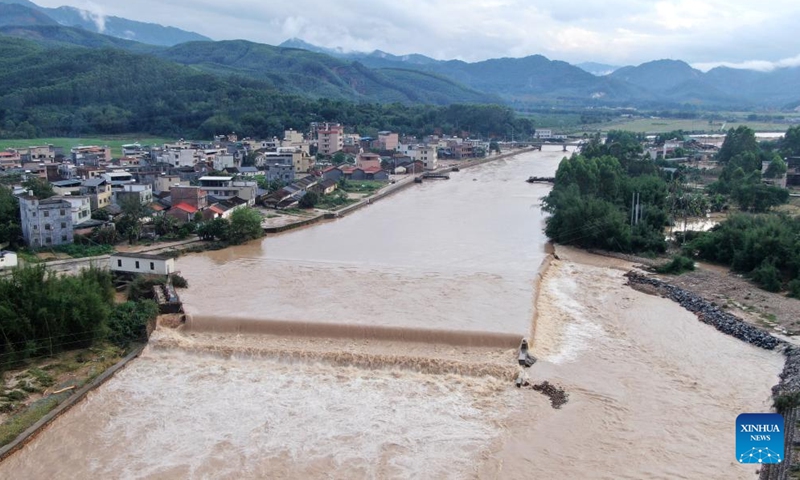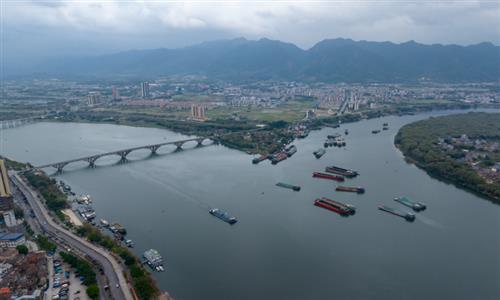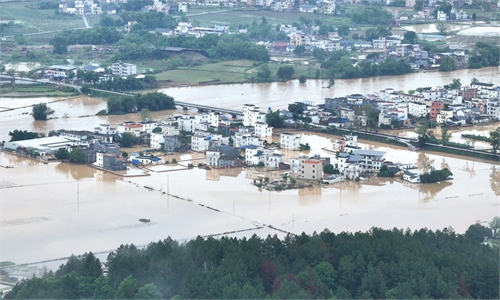Flooded Guangdong, Guangxi respond rapidly to continuing heavy rainfall
Strengthened monitoring, forecasting, early warnings urged to prevent risks

An aerial drone photo taken on April 21, 2024 shows a view of the Beijiang River tributary in Wujiang District of Shaoguan City, south China's Guangdong Province. A total of 38 hydrological stations at 24 rivers in south China's Guangdong Province have reported water levels surpassing the alert threshold as of 4 p.m. on Sunday, according to the provincial department of water resources. (Xinhua/Lu Hanxin)
Flood-affected areas in South China on Monday called for all-out efforts to reduce the impact brought about by the heavy rainfall during recent days including transferring residents, strengthening monitoring frequency and issuing early warnings to safeguard people's lives and property, and preventing secondary disasters such as landslides caused by heavy rainfall.
China's National Meteorological Center on Monday issued a yellow alert for rainstorms and a blue alert for severe convection weather as heavy downpours as well as thunderstorms, gales and hail are anticipated to lash parts of the country, including parts of South China's Guangdong Province and Guangxi Zhuang Autonomous Region, from Monday to Tuesday. China has a four-tier weather warning system, with red being the most severe, followed by orange, yellow and blue.
China's State Flood Control and Drought Relief Headquarters and the Ministry of Emergency Management on Monday continued to coordinate and deploy flood control and disaster relief work in key areas in South China and other regions, to cope with the new round of heavy rainfall.
The Ministry of Water Resources quickly rolled out plans for flood prevention in the Pearl River basin through consultations on Sunday. The current heavy rainfall over a wide coverage area, with high intensity, has lasted for a long period, mainly affecting the Beijiang River, the Dongjiang River and other basins, according to the ministry.
In South China's Guangdong Province, the provincial authorities require further strengthening of emergency rescue work, especially in Shaoguan, Qingyuan and other areas, and that efforts must be carried out against the clock, according to the Guangdong emergency management authorities on Monday.
The central government departments dispatched a total of 15,000 relief supplies, including 6,000 folding beds, 6,000 towels, and other essentials, to rain-battered Guangdong Province on Monday.
It is necessary to enhance monitoring, forecasting, and early warning systems to track heavy rainfall continuously, and provide timely warning information to the public, said the Guangdong authorities.
The disaster in Guangdong has resulted in the deaths of four people, including one rescue worker from Shaoguan. Additionally, 10 people are still missing, according to the Xinhua News Agency on Monday. About 110,000 people have been relocated in Guangdong, said the Xinhua report.
The Pearl River water resources authorities raised the flood control emergency response for flood control to level II on Sunday. The heavy rainfalls have been occurring throughout the basin since April 16, leading 50 rivers to reach flood levels exceeding official warnings, according to the authorities on Monday.
The soldiers of a brigade of the 74th Group Army of the People's Liberation Army (PLA) also quickly mobilized and joined flood relief efforts at the frontlines in Guangdong. Currently, the rescue teams are clearing roads in the affected areas to ensure the deployment of additional rescue forces, according to the official information.
A staff member from the emergency department of Qingyuan, one of the most flood-stricken areas in Guangdong, told the Global Times on Monday that most of the flood-affected residents have been evacuated, while in some areas, there is still flooding.
"On Monday morning, the rain has mostly stopped. The water level in the rivers is still relatively high but is gradually lowering," the staff members said. This year's rainy season started earlier compared to previous years, he noted.
A video footage that a local resident in Shaoguan, Guangdong, sent to the Global Times showed that a hotel's garage has been flooded. A local resident surnamed Yao told the Global Times that some areas still have standing water. Fortunately, Yao's own home is located on higher ground, so her community has not been significantly affected.
The railway transportation service affected by heavy rain in northern Guangdong and other areas has been fully restored. From April 19 to April 21, heavy rainfall has partly affected the operation of the Beijing-Guangzhou and Beijing-Kowloon railways, resulting in 305 trains being canceled or having to be turned back, according to media reports.
As of 5 pm on Sunday, a total of 99,029 people in Guangxi have been affected by the heavy rainfall, with 600 people being evacuated for safety. The affected area of crops is 3,788 hectares, for a direct economic loss of 284.5 million yuan ($39.2 million), according to the local authorities.



